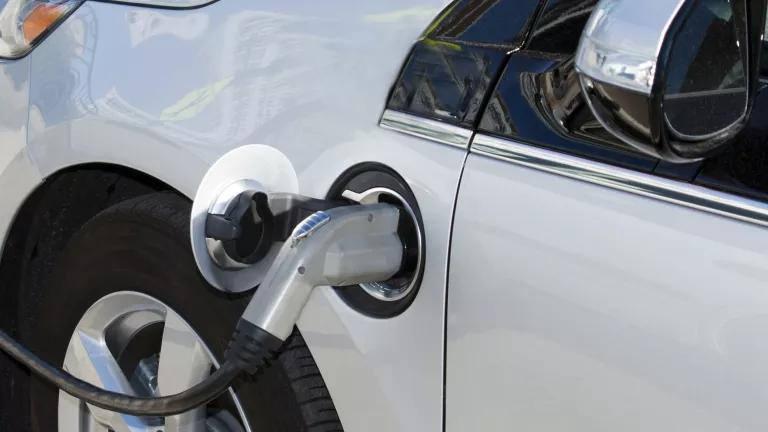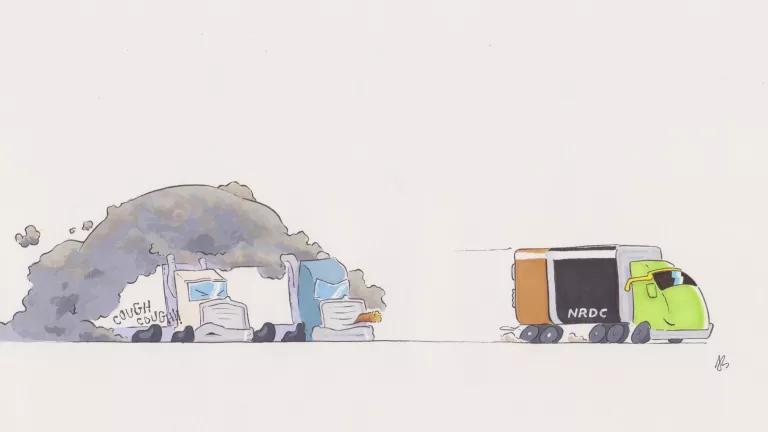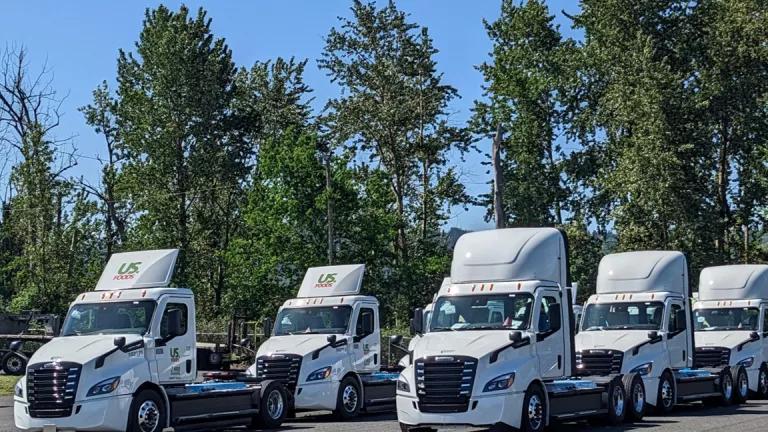This Is Not Your Father’s Automobile Industry
Seven automakers just filed a remarkable brief defending California’s leadership vehicle emissions standards in federal court.

Geri Lavrov/Getty Images
In a historic step, leading automakers just stood up in favor of California’s legal authority to set tailpipe emissions standards.
Seven automakers filed a remarkable brief on Monday in a federal court case over the future of California’s standards. They sided with California and the U.S. EPA (their historical foes) and against the oil industry and its state allies, which are attacking California’s right to set its own auto pollution standards and the right of other states to adopt California’s standards – both core state rights protected under the Clean Air Act. The case, called Ohio v. EPA, is pending in the U.S. Court of Appeals in Washington.
On the brief supporting California are Ford, Volkswagen, BMW, Honda, and Volvo, and (through an association) Tesla and Rivian. They are joined by power companies and others that are creating the electric vehicle charging infrastructure. Not a single car company joined the attack on California.
The automakers’ brief marks a milestone in the industry’s shift over the last 50 years. When I started at NRDC in the 1970s, car companies doggedly opposed virtually all new pollution standards from California or the federal government. And they consistently banded together with oil companies and other polluters in trying to weaken the Clean Air Act.
This is the first time that car companies have gone to court to support California. And there are good business reasons why.
The brief explains the automakers’ goals to go electric and the multibillion dollar investments they are making. Ford, VW, and BMW, for example, say they expect at least half their new vehicle sales to be electric by 2030. Volvo expects all of its sales to be electric by 2030, and Honda by 2040. The companies report combined EV investments approaching $100 billion over the next five years.
The oil industry and its state allies claim California is “forcing” a “wholesale shift” and “fundamentally transforming the automobile industry.” To the contrary, the carmakers respond, “both internal sustainability goals and market forces, including surging consumer demand and the limitations of existing technology,” are prompting their transition toward electric vehicles. And the car companies identify why consumer demand is surging: “Consumers derive numerous benefits from electric vehicles besides emissions reductions, including lower lifetime operating costs and maintenance requirements and ready integration with other consumer technology.”
The oil companies complain that the shift to EVs means they’ll sell less fuel. The carmakers respond that’s the magic of innovation and competition. New products replace old ones all the time: “Reduced interest in legacy products due to technology advancements and consumer preference shifts are an inevitable reality of the market and occur in all sectors of the economy.”
How It Started
Recognizing California’s severe smog and the state’s early efforts to address it, more than 50 years ago Congress explicitly gave the Golden State the authority to go beyond federal pollution standards. And the Clean Air Act allows other states to follow California’s rules. The law instructs EPA to grant California a “waiver” for its standards, which EPA has issued some 75 times.
Using this legal authority, in the 1990s California began ramping up the percentage of zero-emission vehicles it required car makers to sell in order to fight the state’s intractable smog. And under a state law enacted in 2002, California set the first standards for vehicles’ greenhouse gas emissions. These were adopted initially by 13 other states, a number has since grown to 17. At the same time, NRDC joined states and other environmental groups to sue the Bush administration for not setting greenhouse gas standards at the federal level.
These events set off three titanic legal and legislative battles – battles the auto industry lost in quick succession in 2007 and 2008. First, the Supreme Court ruled that carbon dioxide and other heat-trapping emissions from cars and trucks are air pollutants subject to EPA regulation under the Clean Air Act. Second, the carmakers lost a pair of lawsuits to block California’s standards (here and here). Third, enacting the Energy Independence and Security Act, Congress directed the Department of Transportation to make the first major increase in federal fuel economy standards in decades. Notably, Congress rejected various amendments that would have reversed those court decisions and taken away EPA’s and California’s clean air authority.
So the carmakers had to ask themselves how to navigate three regulatory regimes. And early in the Obama administration, the industry, the federal agencies, the states, unions, and environmentalists hammered out agreements to raise standards through 2025, providing both significant carbon pollution reductions and a stable future for carmakers’ planning and investment.
Those agreements held until the Trump administration attempted both to block California and to weaken the federal standards. The ensuing legal fights undermined the carmakers’ past investments and threw their future planning into chaos.
While some companies – notably GM, Toyota, and Chrysler – supported the Trump rollbacks, the leading companies went the other way. Ford, VW, BMW, Honda, and Volvo reached new agreements with California on standards they would meet nationwide, regardless whether the Trump rollbacks succeeded.
How It’s Going
And that brings us to the present case, where those companies are siding with the Biden administration and California to restore the legal framework that they relied on for their planning and investments. Meanwhile, Congress leaned in last year with infrastructure funds and tax incentives to build out the charging network and encourage consumers to go electric.
The market forces driving the transition to EVs are shifting into high gear.
There’s a lot still to be done. The fight in this case concerns the standards through model year 2026. California has adopted standards through 2035 that will continue the transition to electric vehicles. And building on Congress’s historic incentives, EPA is preparing to issue new standards as well. Those need to keep us moving forward nationwide on EVs -- and they also need to keep cutting emissions from the tens of millions of gasoline-powered cars that will be sold before the EV transition is complete.
While the oil industry may keep squawking, the whole auto industry needs to get on board with these steps that are good for both consumers and the climate. Time will tell.
But, in the meantime, progress deserves recognition.
For decades automakers used every trick they could to block commonsense tailpipe pollution and fuel economy standards. But times are changing.
In short, this is not your father’s auto industry. And though it’s not yet the auto industry for your grandkids, it’s on the way.




